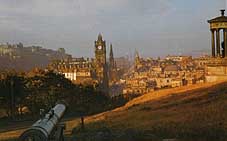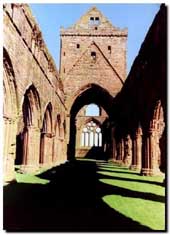 Edinburgh
from Calton Hill
Edinburgh
from Calton Hill
Yes, this is a country which formed a cuisine around
oatmeal. But when we think of Scotland, we also think of Mary Stuart, the
Edinburgh festival, whisky, tartans, frugality, the Loch Ness Monster, and
certainly the ear-assaulting cacophony of bagpipes. It is true that Scotland
is a land of stoic and hardy men with bare and knobbly knees protruding
beneath their kilts, who, in every sort of blustery weather, stand guard
outside the magnificent Edinburgh Castle. Watching these gentlemen stand tall
and proud against a frosty highland breeze gives a glimpse into their
character.
 A
lone piper
A
lone piper
A real Scot is toughed at an early age. But beneath that
hard exterior lies a soul of the romantic. For what could be more romantic
than the wild and wind-swept Scottish sea coasts, or the medieval castles
shrouded in history and folklore? Or the Sweetheart Abbey, a monument, like
India’s Taj Mahal, built to commemorate a great and lasting love?
South of the town of Dumfries, near the coast of the Solway
Firth, Sweetheart Abbey was founded in 1273 by Lady Devorgilla of Galloway, in
memory of her late husband, John Balliol. When she died, her body was laid to
rest before the high alter and a casket containing her husband’s embalmed
heart was placed beside her.
 Sweetheart
Abbey, a monument to love
Sweetheart
Abbey, a monument to love
The Cistercian monks chose the name “Dulce Cor” or
Sweetheart, in her memory. The Abbey was not Lady Devorgilla’s only act of
charity; she also endowed Balliol College in Oxford in 1282. Her son John
Balliol, who became King of Scotland at the behest of King Edward I had his
regalia stripped from him by Edward when he didn’t toe the line.
Despite the ravages of time, a substantial part of this
impressive abbey is still standing, including the nave, the choir, bell tower
and the stonework of the great east window. Sweetheart Abbey also has the most
complete precinct walls still surviving round a Scottish medieval monastery.